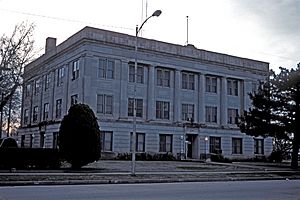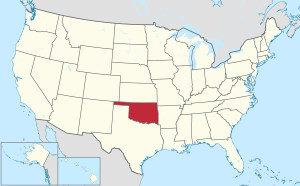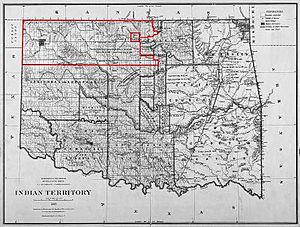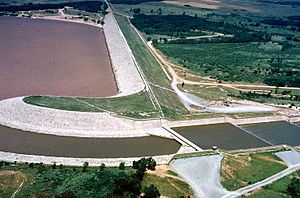Alfalfa County, Oklahoma facts for kids
Quick facts for kids
Alfalfa County
|
|
|---|---|

Alfalfa County Courthouse in Cherokee in 2007
|
|

Location within the U.S. state of Oklahoma
|
|
 Oklahoma's location within the U.S. |
|
| Country | |
| State | |
| Founded | 1907 |
| Named for | William H. "Alfalfa Bill" Murray |
| Seat | Cherokee |
| Largest city | Helena |
| Area | |
| • Total | 881 sq mi (2,280 km2) |
| • Land | 866 sq mi (2,240 km2) |
| • Water | 15 sq mi (40 km2) 1.7%% |
| Population
(2020)
|
|
| • Total | 5,699 |
| • Density | 6.5/sq mi (2.5/km2) |
| Time zone | UTC−6 (Central) |
| • Summer (DST) | UTC−5 (CDT) |
| Congressional district | 3rd |
Alfalfa County is a county in the state of Oklahoma. In 2020, about 5,699 people lived there. The main town, or county seat, is Cherokee.
The county was created in 1907 when Oklahoma became a state. It's named after the alfalfa plant, which grows there, and William H. "Alfalfa Bill" Murray. He was an important leader who helped create Oklahoma's constitution and later became the state's ninth governor.
Contents
History of Alfalfa County
Ancient Times and Native Americans
For thousands of years, Indigenous peoples lived and hunted in the area that is now Alfalfa County. By the 1750s, the Osage tribe became very powerful here. A group led by Chief Black Dog used a special path called the Black Dog Trail.
This trail started in Kansas and went southwest to the Great Salt Plains. The Osage used the plains for hunting and stopped at the springs for their healing powers. They called the nearby river Nescatunga, meaning "big salt water." This is now known as the Salt Fork.
Before Oklahoma Became a State
From 1828 to 1835, treaties made this area part of the Cherokee Outlet. This land was owned by the Cherokee Nation. From 1870 to 1890, raising cattle became the main business. Large cattle companies rented land from the Cherokee people.
In September 1893, Woods County was formed. This happened during the Cherokee Strip Land Run, when many people moved to the area. As more people arrived, the government decided to create Alfalfa County in 1907. This was when Oklahoma officially became a state.
The county was named after William H. "Alfalfa Bill" Murray. He was a key person in creating Oklahoma's constitution and later became governor. He strongly supported the creation of Alfalfa County.
Oklahoma Statehood and Growth
In January 1909, the people of Alfalfa County voted to make Cherokee the county seat. This means Cherokee became the main town for the county government. Other towns like Carmen, Ingersoll, and Jet also wanted to be the county seat.
Many early settlers in Alfalfa County were from Europe. Some were Germans from Russia, who were ethnic Germans that had moved from Russia. Many of these settlers were Mennonites. They settled near towns like Ingersoll, Driftwood, Cherokee, and Goltry.
Railroads played a big part in the county's early success. Lines like the Choctaw Northern (1901) and the Kansas City, Mexico and Orient (1901) helped towns grow. These towns became important places for shipping wheat and for farm businesses.
However, over time, some railroad lines were removed. This caused towns that were no longer on a rail line to shrink. For example, Ingersoll and Driftwood, which were once busy, are no longer officially incorporated towns.
Economy of Alfalfa County
Alfalfa County's economy mainly relies on farming and energy production. Farming here is often done on a large scale. The county is one of the biggest producers of winter wheat in Oklahoma. In 2015, the USDA estimated that the county produced over 5.9 million bushels of winter wheat.
The county also produces a lot of petroleum (oil) and natural gas. In 2012, Alfalfa County was the second-largest producer of natural gas in Oklahoma. It also ranked fifth in crude oil production among Oklahoma counties.
Geography and Nature
Alfalfa County covers about 881 square miles. Most of this is land (866 square miles), and about 15 square miles is water. The county is home to the Great Salt Plains Lake, which is a large lake.
The Great Salt Plains State Park and the Salt Plains National Wildlife Refuge are also located here. These areas are great for seeing wildlife and enjoying nature. The main rivers in the county are the Salt Fork of the Arkansas River and the Medicine Lodge River.
Main Roads
 U.S. Highway 64
U.S. Highway 64 State Highway 8
State Highway 8 State Highway 8B
State Highway 8B State Highway 11
State Highway 11 State Highway 38
State Highway 38 State Highway 45
State Highway 45 State Highway 58
State Highway 58
Neighboring Counties
- Harper County, Kansas (to the northeast)
- Grant County (to the east)
- Garfield County (to the southeast)
- Major County (to the south)
- Woods County (to the west)
- Barber County, Kansas (to the northwest)
Protected Natural Areas
People of Alfalfa County
| Historical population | |||
|---|---|---|---|
| Census | Pop. | %± | |
| 1910 | 18,138 | — | |
| 1920 | 16,253 | −10.4% | |
| 1930 | 15,228 | −6.3% | |
| 1940 | 14,129 | −7.2% | |
| 1950 | 10,699 | −24.3% | |
| 1960 | 8,445 | −21.1% | |
| 1970 | 7,224 | −14.5% | |
| 1980 | 7,077 | −2.0% | |
| 1990 | 6,416 | −9.3% | |
| 2000 | 6,105 | −4.8% | |
| 2010 | 5,642 | −7.6% | |
| 2020 | 5,699 | 1.0% | |
| U.S. Decennial Census 1790-1960 1900-1990 1990-2000 2010 |
|||
In 2010, Alfalfa County had 5,642 people. Most of the people (about 89%) were white. About 4.7% were Black or African American, and 2.9% were Native American. The average age of people in the county was 46 years old. About 18% of the population was under 18, and 20.2% were 65 or older.
Famous People from Alfalfa County
Many interesting people were born in Alfalfa County:
- R. Orin Cornett (1913–2002) was born in Driftwood. He was a physicist who invented Cued Speech. This system helps people with hearing difficulties communicate. He taught at several universities, including Harvard University.
- Beryl Clark (1917–2000) was born in Cherokee. He was a talented football player for the Oklahoma Sooners. He later played professionally for the Chicago Cardinals.
- Harold Keith (1903–1998) was born in Lambert. He became the first sports publicist for the University of Oklahoma. He also won the 1958 Newbery Medal for his historical novel Rifles for Watie.
- Harold G. Kiner (1924–1944) was born in Aline. He was a soldier in World War II. He received the Medal of Honor, the highest military award in the U.S., for his brave actions.
- Wallace "Wally" Parks (1913–2007) was born in Goltry. He founded the National Hot Rod Association (NHRA) in 1951. He helped make drag racing a popular and respected sport.
Towns and Communities
City
- Cherokee (the county seat)
Towns
Other Places
- Nescatunga (a census-designated place)
- Ashley (unincorporated)
- Driftwood (unincorporated)
- Ingersoll (unincorporated)
- Yewed (unincorporated)
Historic Places
Many places in Alfalfa County are listed on the National Register of Historic Places. This means they are important historical sites.
- Alfalfa County Courthouse, Cherokee
- Aline IOOF Lodge No. 263, Aline
- Carmen IOOF Home, Carmen
- Carmen IOOF Lodge No. 84, Carmen
- Cherokee Armory, Cherokee
- Cherokee Friends Church, Cherokee
- Cherokee IOOF Lodge No. 219, Cherokee
- Farmers' Exchange Elevator, Goltry
- Farmers' Federation Elevator, Cherokee
- Hotel Cherokee, Cherokee
- Ingersoll Tile Elevator, Ingersoll
- Sod House, Cleo Springs
See also
 In Spanish: Condado de Alfalfa para niños
In Spanish: Condado de Alfalfa para niños





